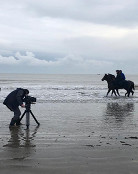Donn's Articles » Level playing field for championship races
Level playing field for championship races
It is around about this time every year that the weight-for-age scale comes up for its annual NCT. You know the process by now: three-year-old wins top all-aged race, three-year-old is acclaimed as high-class, entire three-year-old crop is mooted as better than average, weight-for-age scale comes under scrutiny. Invariably, the scale passes the test. Over 130 years later, with just some minor modifications to the weight-for-age table that is attributed to Admiral Henry John Rous, and it is still on the road.
You can understand the rationale behind the perennial questioning. In an extensive analysis of the weight-for-age scale presented in these pages last Friday, the difficulty in coming up with a universal linear scale – what with horses being living breathing creatures and all, subject to varying degrees and rates of development – was highlighted. Of course it is impossible to come up with a scale that will work for all horses. You cannot determine that all three-year-olds are at a 10lb disadvantage relative to their elders in a race run over a mile at the end of June, but only at a 6lb disadvantage by the end of August.
That said, there were some interesting observations. Racing Post Ratings guru Sam Walker suggested that, according to Racing Post Ratings, three-year-olds should receive 6lb from their elders in the Sussex Stakes, not 8lb, as is the case under the current scale. Roger Varian’s revealed his policy – inherited from his highly astute mentor Michael Jarvis – of generally being happy for his three-year-olds to take on the older horses from July onwards, but not beforehand, believing that the current scale confers an advantage on Classic generation from midsummer.
You can also understand the momentum that the argument has gained this season, with some of the top all-aged Group 1 races going to three-year-olds – Dream Ahead, Nathaniel, Frankel – and the three-year-old theme continued through the weekend with Excelebration winning the Hungerford Stakes, and Census and Brown Panther filling the first two places in the Geoffrey Freer.
Swallows and summers. Just because the Classic generation appears to be rampant this season, it doesn’t mean that the weight-for-age scale is wrong.
However, there is a chance that all this intense analysis of pounds and ounces and rates of development misses the point. Shouldn’t a championship race be exactly that, a championship race? Shouldn’t the object of a championship race be to determine who is the fastest competitor? Shouldn’t the winner of the race be the best contender in it? And therefore, shouldn’t all contestants compete on identical terms?
Of course a weight-for-age scale for the vast majority of all-aged races makes sense, but for a select number of championship races, which could be hand-picked, why couldn’t all horses carry the same weight? A young golfer in a championship event doesn’t tee off from the yellow tees, a young athlete doesn’t receive a 10-yard start, so why should a young racehorse receive a weight allowance?
It is a peculiarity of thoroughbred racing that a significant proportion of the great racehorses of the modern era staked their claim to greatness as three-year-olds. We remember their successes, their performances, we don’t generally think of the weight concession that they enjoyed. Yet when Galileo beat Fantastic Light by two lengths in the King George, he was in receipt of 12lb from the older horse. When Sea The Stars won the Arc, beating Youmzain by two lengths, he was in receipt of 8lb from the runner-up. When Giant’s Causeway won the Eclipse, he was in receipt of 11lb from Kalanisi, and he beat him by a head.
Of course, it is impossible to tell what effect a weight concession has, how much more three-year-old winners had in hand than that which they were required to produce, and it is fanciful in the extreme to suggest that Youmzain would have beaten Sea The Stars in the Arc if both horses had carried the same weight. But it would have been nice to have found out for certain.
There is the chance that identical weights for all horses in a championship races would make those races less attractive for connections of three-year-olds than they are at present, and the King George in particular has struggled of late to attract the Classic generation. But there are other factors at play in the King George, and other all-aged championship races do not suffer similarly. In the last eight renewals of the Arc de Triomphe, for example, the race that is now generally recognised as the all-aged middle-distance championship race of Europe, 52 three-year-olds have taken part as against 67 older horses. Seven of the last eight winners were three-year-olds, and that doesn’t seem right.
Conversely, there is a chance that the race would be more attractive for three-year-olds. The prestige and the consequent stud value of a three-year-old who could beat his or her elders at level weights should soar. It might prove to be a rare occurrence, but that should only add to the perceived magnitude of the feat and the consequent commercial value of the horse.
And if it was a rare thing that a three-year-old beat the older horses in a championship race, it should also result indirectly in more high class horses remaining in training as four-year-olds than is currently the case, and that could only be a good thing.
© The Racing Post, 16th July 2011


 Follow Donn
Follow Donn